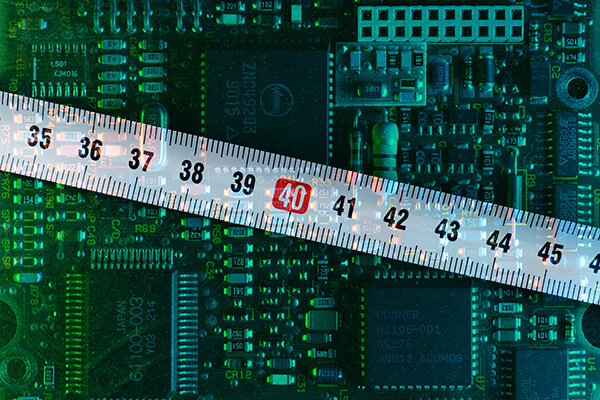Parylene Coating Thickness – How Much is Enough?

Sean Clancy, Ph.D. | August 18, 2020
If you are considering a Parylene coating for your printed circuit board assembly, you may wonder what thickness you should use. You may have surmised that the more coating, the better, but that is not always the case. The thicker the coating, the longer it takes to coat – you will face diminishing returns at some point. Additionally, no universal thickness is ideal for all operating environments and applications. Different applications have different functional requirements.
To gain a better understanding, let’s look into how Parylene coating works and how to determine what Parylene thickness is most suitable for your requirements.
What is the Parylene Coating Process?
The Parylene chemical vapor deposition process begins with dimer, which is a powdered chemical. The more dimer that is in the first chamber, the thicker the coating will be. The dimer is heated into vapor, which is pulled by a vacuum into a connected chamber, and heated to an even higher temperature, further pyrolyzing the dimer. It is pulled into a final deposition chamber, penetrating crevices, coating exposed surfaces, and becoming a polymer. The resulting coating exhibits strong barrier properties at 50% thickness of conventional conformal coatings.
Read about Parylene biocompatibility and Parylene removal
What Parylene Thickness is Best?
- Are there Parylene cost considerations to meet, or do you need to meet the highest level of protection, no matter the price?
- Are there time constraints?
- Do you need to meet industry-standard requirements?
When Time is an Issue
Do you have a project that needed to be completed yesterday? A thinner coating may be your best bet. However, you risk breaches or pinholes in the coating when you go thin, say, 0.1 to 5 μm (microns). If your product has simple geometry or relatively flat structures, your coating will probably be pinhole-free.
But for products with more substantial differences in structural or component heights or components with more complex geometry, this level of thinness may not offer enough coating material to form a coherent film, leaving voids or pinholes. And any breaches in the film are potential pathways for the ingress of corrosive compounds and would require Parylene removal.
On the other hand, a thinner coating may provide a sufficient level of protection for products not exposed to corrosives, such as products requiring only a quality barrier against minimal exposure to contamination. Additionally, you decrease the time to coat and cost when you go thin.

For Product Reliability
Is product reliability the largest of your concerns? The IPC-CC-830 and MIL-I-46058 coating standards might be good references. According to these standards, thickness ranges of 12.5 to 18 and 12.5 to 25 μm, respectively, are thick enough for protection against very harsh environments. Coatings this thick are pinhole-free for a myriad of products and are time-tested, with decades of usage in demanding industries such as defense, aerospace, medical device, and telecommunications.
For products in the most demanding of environments, the NASA-STD 8739.1 standard calls for a range of thicknesses from 13 to 51 μm. This thickness is more than sufficient to provide a level of protection for incredibly harsh environments. Bear in mind, however, that at thicknesses around 50 μm, a single coating run may take well over a day, depending on the Parylene type you have selected.
Read about Parylene C and Parylene N
The Big Picture
There is no optimal Parylene coating thickness across all applications and requirements. Instead, you should select a thickness based upon several factors, such as the operating environment that your product will be exposed to, and how your customers expect to use the product. Additionally, budget and timeframe are essential factors. Although there is no perfect thickness of coating suitable for every application, with enough planning, you can find the perfect thickness suitable for yours.
Although there is no perfect thickness of coating suitable for every application, with enough planning, you can find the perfect thickness suitable for yours.
Not Sure Which Parylene Thickness is Ideal for Your Product?
If you have questions or problems with Parylene, we’ve got a solution. To speak to an applications engineer about your specific requirements, Parylene coating cost, and how to determine which thickness is best, contact us today for a quote. We can help with automated Parylene masking and scalable Parylene coating equipment.
Sean Clancy, Ph.D.
To view Dr. Clancy’s webinar, “Proven Methods for Achieving Advanced Product Performance and Protection From Corrosive Environments”, visit here.

 Ryan Moore
Ryan Moore
Ryan is a 9-year veteran to the world of protecting electronics from harsh environments and a lover of all things technology.
Related
Discover how HZO can protect your product
